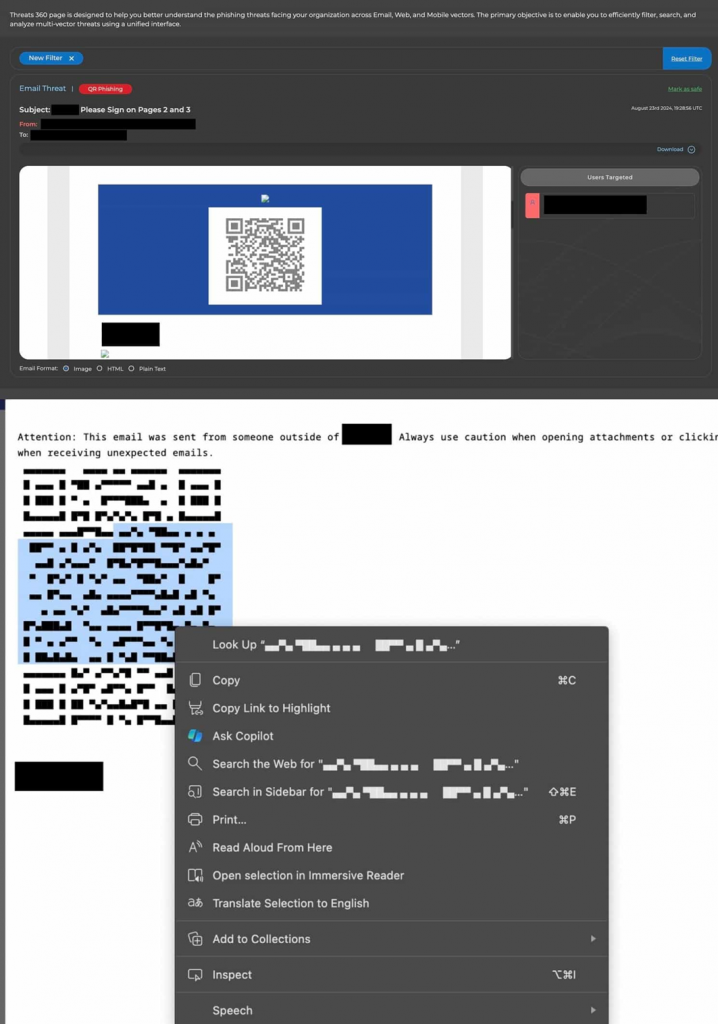Friend
Professional
- Messages
- 2,675
- Reaction score
- 1,002
- Points
- 113
No spam filter has yet been able to recognize the new symbolic threat.
Experts from SlashNext have identified a dangerous phishing technique called "Unicode QR Code Phishing" that requires close attention. This sophisticated method bypasses traditional security measures and endangers users by giving hackers access to malicious techniques and data theft.
In the last decade, QR codes have become an integral part of our digital lives, providing convenient access to information and websites. However, this convenience has brought them to the attention of cybercriminals, leading to a surge in QR code attacks.
According to statistics, at the beginning of 2024, the number of phishing attacks using QR codes increased by 587%. Check Point Software Technologies recorded 20,000 cases of such attacks in the first two weeks of the year, highlighting the vulnerability of QR codes to malicious use.
Traditionally, phishing using QR codes involved embedding images of QR codes in emails or other messages. These codes, when scanned, redirected users to malicious sites or performed other dangerous actions.
Most cybersecurity companies have developed effective methods to detect and block such threats over time, however, attackers have come up with a new way to trick users by creating QR codes using Unicode text characters instead of images.

This new technique presents a major challenge to traditional security measures, as most security tools are set up to look for suspicious images, while symbolic QR codes pass by such checks.
Moreover, despite their text-based nature, these malicious codes look exactly the same as regular ones, so they can be easily read by smartphone cameras, allowing attackers to successfully carry out long chains of infections.
This unique approach has a significant impact on the security of both professionals and users. The QR code detection mechanisms used today may not be effective against such attacks, putting even those users who are usually cautious when scanning QR codes at risk.
SlashNext's research highlights the need for a holistic approach to security. Phishing attacks are no longer limited to email and can occur on a variety of platforms. To effectively protect against such threats, organizations must implement multi-layered security strategies.
Users are advised to avoid scanning QR codes from unknown sources, especially those that come in emails or messages. Using high-quality mobile security solutions, as well as security extensions in real-time browsers, can significantly reduce risks.
Source
Experts from SlashNext have identified a dangerous phishing technique called "Unicode QR Code Phishing" that requires close attention. This sophisticated method bypasses traditional security measures and endangers users by giving hackers access to malicious techniques and data theft.
In the last decade, QR codes have become an integral part of our digital lives, providing convenient access to information and websites. However, this convenience has brought them to the attention of cybercriminals, leading to a surge in QR code attacks.
According to statistics, at the beginning of 2024, the number of phishing attacks using QR codes increased by 587%. Check Point Software Technologies recorded 20,000 cases of such attacks in the first two weeks of the year, highlighting the vulnerability of QR codes to malicious use.
Traditionally, phishing using QR codes involved embedding images of QR codes in emails or other messages. These codes, when scanned, redirected users to malicious sites or performed other dangerous actions.
Most cybersecurity companies have developed effective methods to detect and block such threats over time, however, attackers have come up with a new way to trick users by creating QR codes using Unicode text characters instead of images.

This new technique presents a major challenge to traditional security measures, as most security tools are set up to look for suspicious images, while symbolic QR codes pass by such checks.
Moreover, despite their text-based nature, these malicious codes look exactly the same as regular ones, so they can be easily read by smartphone cameras, allowing attackers to successfully carry out long chains of infections.
This unique approach has a significant impact on the security of both professionals and users. The QR code detection mechanisms used today may not be effective against such attacks, putting even those users who are usually cautious when scanning QR codes at risk.
SlashNext's research highlights the need for a holistic approach to security. Phishing attacks are no longer limited to email and can occur on a variety of platforms. To effectively protect against such threats, organizations must implement multi-layered security strategies.
Users are advised to avoid scanning QR codes from unknown sources, especially those that come in emails or messages. Using high-quality mobile security solutions, as well as security extensions in real-time browsers, can significantly reduce risks.
Source
